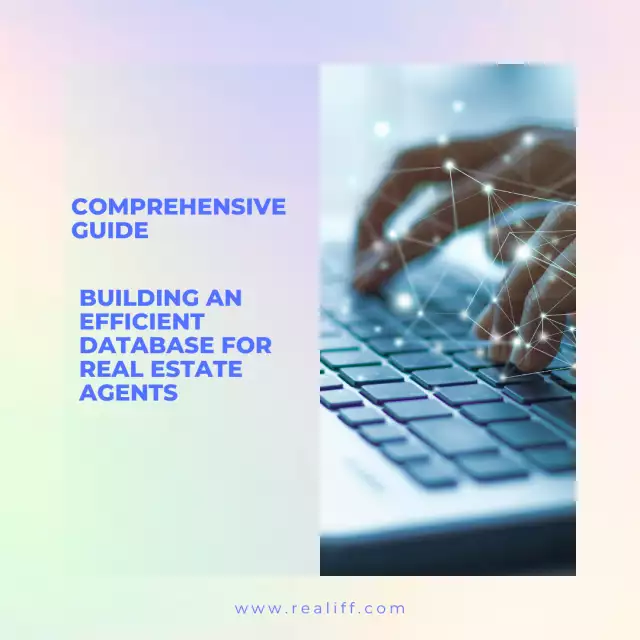Building an Efficient Database for Real Estate Agents: A Comprehensive Guide
Building an Efficient Database for Real Estate Agents: A Comprehensive Guide
In today's fast-paced real estate industry, having a well-organized and easily accessible database is crucial for real estate agents to manage their clients, properties, and transactions effectively. In this blog post, we will provide a step-by-step guide on how to build a comprehensive database tailored specifically for real estate agents. By following these guidelines, you'll be able to streamline your operations, improve client management, and ultimately boost your productivity and success in the market.
Define Your Database Objectives
To start building a database for real estate agents, it is essential to define the objectives of the database. This involves identifying the specific goals and requirements of your real estate business. Consider the types of data you need to store, such as client information, property details, transaction history, and more. Additionally, think about the scalability and future growth of your database to accommodate expanding business needs. By clearly defining your objectives, you can lay the foundation for a robust and efficient database system.
Choose the Right Database Management System (DBMS)
Selecting the appropriate Database Management System (DBMS) is a critical decision when building a database for real estate agents. Research and compare different DBMS options such as MySQL, PostgreSQL, Microsoft SQL Server, and others. Consider factors like ease of use, scalability, security, and compatibility with your preferred programming language or framework. Assess the specific requirements of your real estate businessand choose a DBMS that best aligns with those needs. A well-chosen DBMS will provide the foundation for efficient data storage, retrieval, and management.
Design a Logical Database Structure
Designing a logical database structure is the next step in building a database for real estate agents. Identify the entities relevant to your real estate business, such as clients, properties, transactions, and contacts. Determine the relationships between these entities, ensuring a logical and efficient structure. One helpful tool for visualizing and planning the database structure is an entity-relationship diagram (ERD). By using an ERD, you can represent entities, attributes, and relationships, providing a blueprint for the database design. This step is crucial as it sets the groundwork for organizing and managing data effectively.
Create the Database Schema
With the logical structure in place, it's time to create the database schema. The schema maps out the entities, attributes, and relationships identified in the previous step into a physical database design. Begin by creating the necessary tables to represent each entity, and defining the attributes and appropriate data types for each table column. Establish primary and foreign keys to establish relationships between tables, ensuring data integrity and efficient retrieval. Additionally, consider indexing strategies to optimize query performance for commonly accessed data. A well-designed database schema lays the foundation for a robust and scalable real estate database.
Real Estate 101: Understanding Key Terms and Definitions (Part 2)
Implement the Database
After designing the schema, it's time to implement the database using the chosen DBMS. Utilize the features and tools provided by the DBMS to create the physical database according to the defined schema. This involves creating the tables, establishing relationships, and defining the necessary constraints and data types for each attribute. It is crucial to follow best practices for data normalization, such as the first normal form (1NF), second normal form (2NF), and third normal form (3NF), to minimize data redundancy and improve data integrity. Careful implementation of the database ensures accurate data storage and efficient query processing.
Develop User-Friendly Interfaces
Building user-friendly interfaces is essential for real estate agents to interact with the database efficiently. Create a user interface (UI) that allows easy data entry, retrieval, and management. Consider using web-based or mobile applications to provide convenient access to the database on multiple devices. The UI should be intuitive and user-friendly, allowing agents to easily search for and update client information, property details, and transaction records. Implement search and filtering functionalities to efficiently retrieve specific client or property information based on various criteria such as location, price range, and property type. Incorporating features like dropdown menus, auto-fill fields, and data validation can enhance the user experience and minimize errors during data entry. Additionally, consider integrating communication tools such as email or messaging features to facilitate seamless communication between agents and clients within the database interface.
Secure the Database
Ensuring the security of the database and the sensitive information it holds is paramount for real estate agents. Implement robust security measures to protect client data from unauthorized access or breaches. Utilize authentication mechanisms to control access to the database, requiring unique login credentials for each user. Consider implementing role-based access control (RBAC) to define different levels of access based on user roles and responsibilities within the real estate agency. Encrypt sensitive data, such as client contact details and financial information, to prevent unauthorized viewing or manipulation. Regularly update and patch the DBMS software to address any security vulnerabilities. Implementing regular database backups and offsite storage safeguards against data loss due to hardware failure, natural disasters, or cyber-attacks.
Regular Maintenance and Upgrades
Building a database for real estate agents is an ongoing process that requires regular maintenance and upgrades. Schedule routine maintenance tasks, such as database backups, indexing, and performance tuning, to ensure optimal database performance. Monitor and analyze the database usage patterns to identify areas for improvement and optimization. Stay up-to-date with the latest updates and security patches for the chosen DBMS to protect against new threats. Consider automating processes such as data synchronization with external systems, periodic backups, and data purging to streamline operations and reduce manual efforts. Regularly review and refine the database structure based on changing business needs and evolving industry standards.
Conclusion
Building a comprehensive database for real estate agents is essential for efficient client management, property tracking, and transaction processing. By following the step-by-step guide outlined in this blog post, real estate agents can create a well-organized and secure database system that enhances productivity, streamlines operations and contributes to long-term success in the real estate industry.


